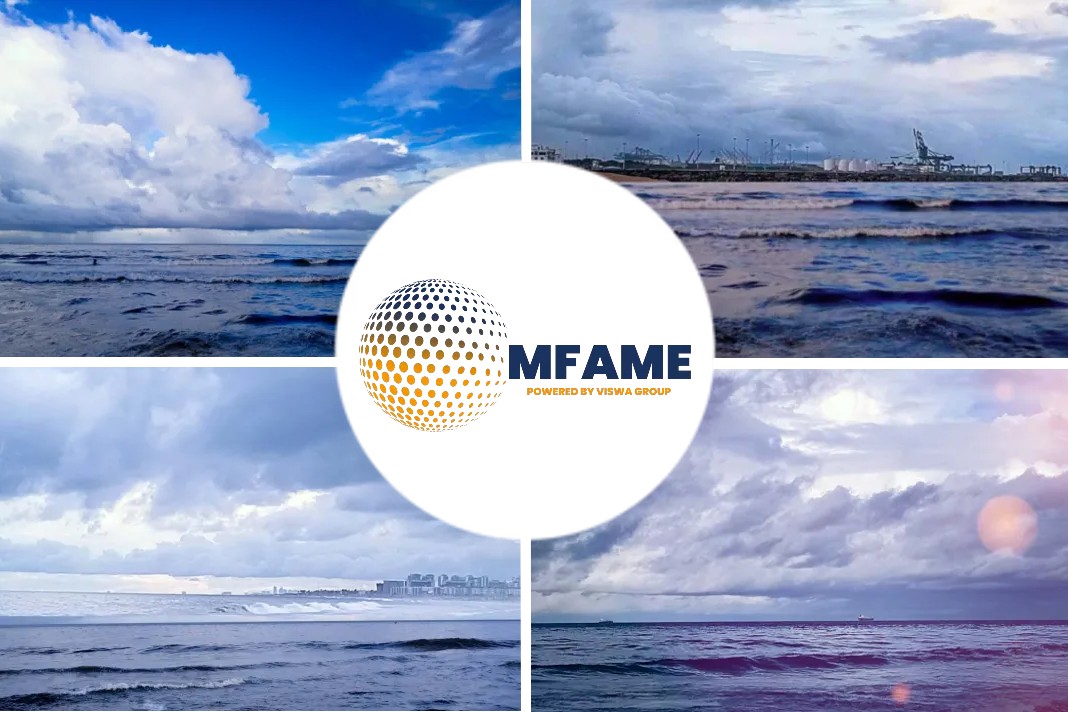The many industries that make up the world of freight have undergone tremendous change over the past several decades. Each week, FreightWaves explores the archives of American Shipper’s nearly 70-year-old collection of shipping and maritime publications to showcase interesting freight stories of long ago.
In this week’s edition, from the May 2001 issue of American Shipper (virtual pages 52-53), FreightWaves Flashback looks back 20 years ago at plans to push the envelope on containerized shipping.
Associated Risks
Several shipping lines are close to ordering the first container ships of more than 8,000-TEU capacity, but others in the industry are warning of the associated risks.
China Shipping Container Lines is talking to the Korean shipyard Samsung Heavy Industries about orders for a series of 9,000-TEU containerships. When concluded, the orders will be for the world’s largest container ships, overtaking Maersk Sealand’s “S-class” vessels of about 8,000-TEU effective capacity.
A spokesman for the shipyard in Korea told American Shipper that negotiations are underway, following the signing of a letter of intent concerning future orders of 9,000-TEU ships.
Development of Larger
Samsung, a shipyard that has led the development of larger post-Panamax container ships in Asia, has designed a 9,000-TEU prototype container ship with a length of 330 meters, a draft of 14.5 meters, a width of 45.6 meters and a speed of 26 knots. The width of the ship implies that it will carry 18 containers abreast, one more than the largest container ships afloat today. The vessels would be considerably wider than the 13-container-wide, 32.3-meters Panamax vessel type.
The wider vessels will require container terminals to invest in longer cranes that can work 18-container-wide vessels.
Robert Woods, group managing director of P&O Nedlloyd, recently said his company is looking at vessel designs for larger ships of up 10,000-TEU capacity.
Meanwhile, Dutch academics are continuing studies about the sustainability of introducing, by 2010, a revolutionary vessel type called the Malacca-max. The 18,000-TEU Malacca-max vessels would have the maximum size and draft to transit the Strait of Malacca in Southeast Asia (February American Shipper, pages 68-69).
Cost Advantage?
Few in the liner shipping industry today question the cost advantage of post-Panamax container ships. All the major container ship operators have built or ordered vessels of more than 5,000-TEU capacity of this type, even round-the-world operator Evergreen, which uses them mainly for its Asia/U.S. West Coast operations.
The post-Panamax ship is quickly becoming the workhorse of the Asia/Europe and Asia/U.S. West Coast trades.
Global Liner Shipping Database
According to ComPairData, the global liner shipping database, 58 of the 430 liner vessels used in the Asia/North America trade are post-Panamax container ships of more than 5,000 TEUs. In the Asia/Europe trade, 81 of the 341 vessels in this trade are bigger than 5,000 TEU. Certain ships operate in both the trans-Pacific and Asia/Europe trades as part of long “pendulum” rotations. However, by definition, all the ships employed in the booming Asia/Panama/U.S. East Coast all-water trade is of Panamax size or less.
The number of post-Panamax vessels will double over the next two years.
Since 1996, the trend from 5,000-TEU to 7,000-TEU vessels has taken hold, following the introduction by Maersk Line (now Maersk Sealand) of the Regina Maersk (see table).
OOCL Ordered
Last November, Hong Kong-based Orient Overseas (International) Ltd., the parent company of OOCL, ordered two 7,400-TEU container ships from the Korean shipbuilder Samsung Heavy Industries. They are expected to be delivered in the second quarter of 2003. The two post-Panamax container ships will cost a total of $160 million, Orient Overseas (International) Ltd. said.
Last year, Hapag-Lloyd ordered four 7,200-TEU, 42.8-meter-wide container ships from the Hyundai shipyard. The first ship in the series is due to be delivered this fall.
And NYK and P&O Nedlloyd, two carriers that were among the first to deploy vessels of more than 6,000-TEU capacity, have ordered more ships of the same type.
New Series of Container Ships
According to unconfirmed reports, the new series of container ships being built by the secretive A.P. Moller Group at its Odense shipyard in Denmark may be of 10,000-TEU capacity rather than 6,000 TEU as stated officially by group affiliate Maersk Sealand. Maersk Sealand has a history of surprising the industry by initially understating the true capacity of its new vessel designs.
Meanwhile, CMA CGM — a partner of China Shipping — and a German nonoperating charter owner are believed to be involved in negotiations for orders for 9,000-TEU vessels from the Samsung shipyard. CMA CGM would not comment on this development.
Critics
But the constant upsizing of container ships has led to a debate about how much bigger vessels should get until they reach the limits of the overall transportation system. Is handling a 9,000-TEU behemoth really the same as handling two 4,500-TEU ones?
Shipping lines should carefully consider the impact on inland transportation operations and service levels before ordering giant container ships with capacities of 9,000 TEUs or larger, warned Zenzaburo Wakabayashi, executive vice president of “K” Line.
“We need to seriously consider a number of consequences, as this is more than just a matter of ship size,” Wakabayashi said at a recent Containerisation International conference in London.
“Container vessels of close to 9,000 TEU or even bigger have recently been tabled,” he said. “Will this make the best sense?”
Wakabayashi told American Shipper that the operation of 9,000-TEU ships raises terminal, intermodal and commercial issues.
Important Subject
“As someone who is reasonably concerned about the future of the industry, I would want to be reasonably careful about this important subject before endorsing any new mega-size scheme,” Wakabayashi said. He said that infrastructure areas to be considered include terminal facilities, yard space, gantry crane capacity and productivity, chassis logistics, computer systems and inland transportation.
Scale economies may result in a lower cost of slot on board mega-vessels, Wakabayashi said. But such vessels may adversely impact service quality, as three or four days would elapse from the time the first container is unloaded in port to the time the last container leaves the port.
Intermodal Rail Transportation
If 9,000-TEU ships are operated in the trans-Pacific between South China/Hong Kong and a California port, about 4,000 containers of 40-foot will be discharged in the single U.S. port of call. Of these, more than half would be destined for intermodal rail transportation, he said.
“One train is physically limited to 240 40-foot containers,” Wakabayashi said. Therefore, about 10 double-stack trains would have to be arranged to move the inbound containers from one such ship.
“Unless those problems can be solved through infrastructure improvement, I think it would be extremely difficult to simply accept and welcome such a trend towards jumbo-sized ships as an answer for improving service,” Wakabayashi said.
Port-to-Port Transit
He also warned that if it takes four days from the ship arrival to the unloading of the last inbound container, the real transit will stretch from eight days for the first container discharged to 12 days for the last one, for a typical port-to-port transit.
“Four more days … is not competitive,” he said, adding that shippers may have to be given a lower freight rate for slower-moving containers.
“K” Line has ordered a series of 12 post-Panamax vessels of 5,500 TEU and has thus been conservative in their size compared to other shipping lines.
Very Large Vessels
For shipping lines and for ports, another risk associated with the operation of very large vessels is the prospect that they could spend a higher proportion of their time in port than today, despite their substantially higher capital costs.
Relatively little is known publicly today about the additional land and rail link requirements of future large vessels.
But many large terminals have already installed large container gantry cranes that can handle 19-container-wide vessels.
Cost Saving
Wakabayashi said the port-to-port cost savings from operating a 9,000-TEU ship is “perhaps $150” per trip per TEU, but would only be achieved if the vessel was fully utilized. He echoed a criticism made recently by Martin Stopford, research director of London-based shipbroker Clarkson, that such ship economies are small.
It is known that vessel operating and port expenses represent only about one-third of the cost of moving a container from door to door.
However, a spokesman for Samsung argued that savings from very large container ships are real.
Transportation Cost
“It is expected that, with this 9,000-TEU-class vessel, the transportation cost can be reduced by more than 17.7%” compared to the alternative of utilizing two 4,500-TEU vessels to move the same volume of cargo. The unit cost per TEU comes to $171 for a 9,000-TEU ship, as compared to $208 for a 4,500-TEU vessel, according to Samsung.
“The company has endeavored to develop an optimum vessel prototype in consideration of the present status of the facilities and cargo-handling equipment at major ports of the world and their plans for expansion of the facilities,” the shipyard said, referring to the 9,000-TEU design.
Major Carriers Suggest
Public statements made by major carriers suggest that no shipping line today is considering building the ships of 12,000-TEU or even 18,000-TEU capacity advocated by the Dutch academic Niko Wijnolst and associates from Delft University.
However, the Korean shipyard Samsung said recently that it is pushing ahead with a plan to develop a 14,000-TEU vessel design.
Did you subscribe to our daily newsletter?
It’s Free! Click here to Subscribe!
Source: freight waves


















